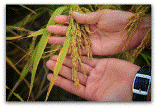2012
Principles of Carbon Catabolite Repression in the Rice Blast Fungus: Tps1, Nmr1-3, and a MATE–Family Pump Regulate Glucose Metabolism during Infection, Jessie Fernandez, Janet D. Wright, David E. Hartline, Cristian Fernando Quispe, Nandakumar Madayiputhiya, and Richard A. Wilson
2011
The Sugar Sensor, Trehalose-6-Phosphate Synthase (Tps1), Regulates Primary and Secondary Metabolism during Infection by the Rice Blast Fungus: Will Magnaporthe oryzae’s “Sweet Tooth” become Its “Achilles’ Heel”?, Jessie Fernandez and Richard A. Wilson
Fungal Virulence and Development Is Regulated by Alternative Pre-mRNA 3′End Processing in Magnaporthe oryzae, Marina Franceschetti, Emilio Bueno, Richard A. Wilson, Sara L. Tucker, Concepción Gómez-Mena, Grant Calder, and Ane Sesma
GATA-Family Transcription Factors in Magnaporthe oryzae, Cristian F. Quispe
2010
An NADPH-Dependent Genetic Switch Regulates Plant Infection by the Rice Blast Fungus, Richard A. Wilson, Robert P. Gibson, Cristian Quispe, Jennifer A. Littlechild, and Nicholas J. Talbot
2009
Oxygenase Coordination Is Required for Morphological Transition and the Host-Fungus Interaction of Aspergillus flavus, Sigal Horowitz Brown, James B. Scott, Jeyanthi Bhaheetharan, William C. Sharpee, Lane Milde, and Richard A. Wilson
Under Pressure: Investigating the Biology of Plant Infection by Magnaporthe oryza, Nicholas J. Talbot and Richard A. Wilson
Fungal Physiology: A Future Perspective, Richard A. Wilson and Nicholas J. Talbot
2005
Fundamental Contribution of β-Oxidation to Polyketide Mycotoxin Production In Planta, Lori A. Maggio-Hall, Richard A. Wilson, and Nancy P. Keller
2004
Deletion of the Δ12-Oleic Acid Desaturase Gene of a Nonaflatoxigenic Aspergillus parasiticus Field Isolate Affects Conidiation and Sclerotial Development, Perng Kuang Chang, Richard A. Wilson, Nancy P. Keller, and Thomas E. Cleveland
Characterization of the Aspergillus parasiticus Δ12-Desaturase Gene: A Role for Lipid Metabolism in the Aspergillus-Seed Interaction, Richard A. Wilson, Ana M. Calvo, Perng-Kuang Chang, and Nancy P. Keller
Two Δ9-Stearic Acid Desaturases Are Required for Aspergillus nidulans Growth and Development, Richard A. Wilson, Perng-Kuang Chang, Agnieszka Dobrzyn, James B. Ntambi, Robert Zarnowski, and Nancy P. Keller
2002
Relationship between Secondary Metabolism and Fungal Development, Ana M. Calvo, Richard A. Wilson, Jin Woo Bok, and Nancy P. Keller
2001
Cultivar-Dependent Expression of a Maize Lipoxygenase Responsive to Seed Infesting Fungi, Richard A. Wilson, Harold W. Gardner, and Nancy P. Keller
1998
Mutational Analysis of AREA, a Transcriptional Activator Mediating Nitrogen Metabolite Repression in Aspergillus nidulans and a Member of the “Streetwise” GATA Family of Transcription Factors, Richard A. Wilson and Herbert N. Arst Jr.

